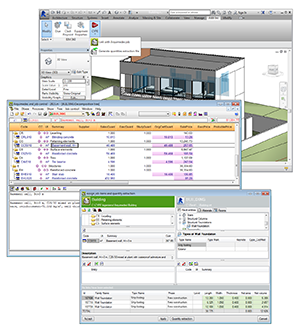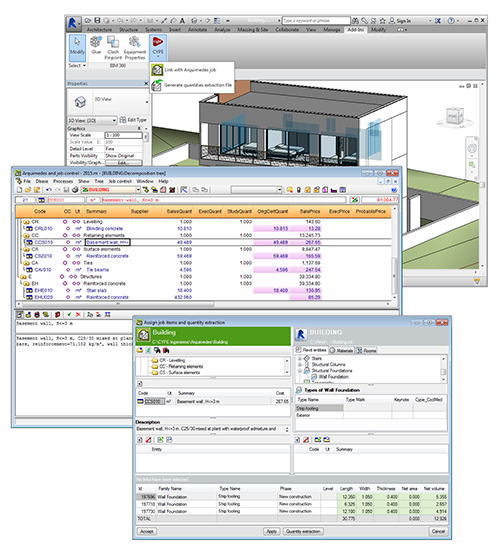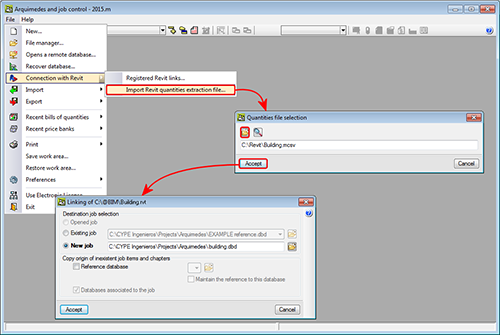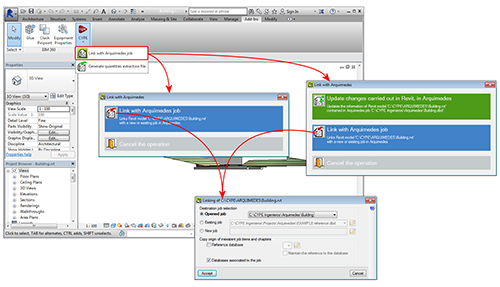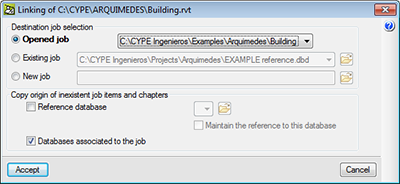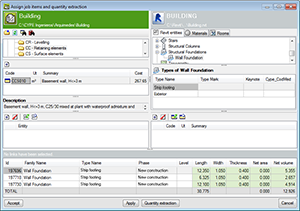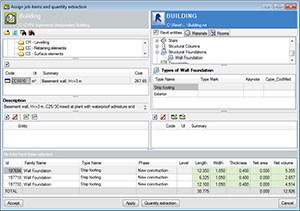- CYPE >
- english >
- products >
- arquimedes >
- Bill of quantities of BIM models

The "Bill of quantities of BIM models" module of Arquimedes creates a direct connection between Arquimedes (CYPE) and Revit (AutoDesk) (2015 and later versions), and has been designed to obtain the quantities and generate the bill of quantities based on a Revit BIM model.
The module installs a CYPE add-in in Revit. This allows users to work simultaneously in both programs (Arquimedes and Revit) or only in Arquimedes by importing the file generated by the CYPE add-in in Revit, which contains the complete Revit model.
"Bill of quantities of BIM models" is also permission from the user license that allows users to work with the "Open BIM Quantities" program (which has been created to generate the bill of quantities of BIM models defined on the BIMserver.center platform). On this current page, you can find out more about how "Bill of quantities of BIM models" works as an Arquimedes module. On the "Open BIM Quantities" page, you can obtain more information about this other application.
Properties of the "Bill of quantities of BIM models" module
- Integration in the Revit workspace, simultaneous work with Revit, Arquimedes and its "Bill of quantities of BIM models" module. Work can be carried out on two screens.
- Complete interaction between Revit, Arquimedes and any of its modules (Purchase management, Automatic quantity import from drawings and link with CAD programs, BOQ consolidation).
- Complete reading of Revit model information (Families, Categories, Types, Elements, system and user parameters, etc.). File zone, so information associated with Categories, Types and Elements, Rooms, Materials and Phases may be selected easily. Column data organisation and filtering. Location of elements using "IDs" and visually, with the element displayed highlighted and isolated in the BIM model when found. Selection of cells, columns or rows in data tables, or selection of complete data tables to copy, print or export.
- Based on the Revit model, the "Bill of quantities of BIM models" module obtains the quantities from an open bill of quantities, from an existing bill of quantities which is not open or allows users to create a new bill of quantities based on a BIM model. New job items can be added at any time.
- Measurements can be taken by element in the Revit model and by material. Furthermore, it can provide a cost estimate for rooms, or groups of job items for a specific room.
- Automatically assigns job items to elements of the BIM model if they contain the Keynote parameter in the code of the job item of the bill of quantities to be measured. Hence, Revit model-type templates can be kept with elements associated with job items of an Arquimedes reference database using the "Keynote" parameter and so, reduce the manual assigning tasks later on.
- Several job items can be assigned to a Type to then obtain its quantities. For example, consider the Type: "Basic wall"; the job items: "Internal ceramic brick partition to be cladded" and "Plastic paint on internal plastered surfaces" can be assigned to it.
- Several Revit jobs or projects can be linked to the same bill of quantities in Arquimedes. Usually, several Revit models are linked to the same bill of quantities: the architectural model, structural model and building services model. In this case, the BOQ consolidation module of Arquimedes is essential, as it unifies all the chapters and job items obtained from CYPECAD and CYPECAD MEP in a single bill of quantities, hence saving a lot of time, work and avoiding errors or forgetting to include job items.
- Automatically detects the measurement units when assigning a job item to the element of the BIM model and assigns the most appropriate dimension combination to obtain quantity lines by Element. The combination used to obtain the quantities can be modified, to a user defined combination. Creation of comments for quantity lines can also be edited.
- Formulas used to obtain the quantities can be personalised. Users can change, in accordance with their criteria, how a specific category is measured, even using formulas.
- A change tracking system identifies the Categories, Types and Elements that have changed after the quantities have been extracted, and identifies the lines from the Revit model and from the user in the bill of quantities.
- The elements corresponding to the selected quantity lines can be identified in the Revit model.
- After the quantity export/extraction, there is no obligation to have a Revit license. The company is not obliged to have an assigned license for whoever carries out the quantity measurement, since no further work with Revit is required.
- Whoever carries out the quantity measurements is not required to have any knowledge on how to manage Revit. With a few hours of training, users can understand what a Revit BIM model is like and how to manage it with Arquimedes.
- Quantities do not have to be measured in Revit, since the Revit model is obtained for external work, and therefore, users are not required to be connected in the same "network" to share the core project file.
Direct connection between Revit and Arquimedes to obtain quantities from a BIM model
The “Bill of quantities of BIM models” module allows users to obtain the quantities in Arquimedes and hence, the bill of quantities from a Revit model.
Quantities can be incorporated into a new or existing (estimate) bill of quantities in Arquimedes:
- No previous bill of quantities exists:
Using the “Bill of quantities of BIM models” module, users can link the job modelled in Revit with a new Arquimedes job which can, at the same time, be linked to any database that can be read by Arquimedes. Users introduce job items in Arquimedes, which represent each element in the Revit model and these are linked in the program. The “Bill of quantities of BIM models” module generates the quantities from the information it extracts from the Revit model, and so creating the structure of the bill of quantities in Arquimedes.
If there are construction elements with keynotes which coincide with the job item codes of the associated database, they will be introduced automatically in the bill of quantities. It will be linked with the corresponding construction element and its quantities generated. - There is an existing bill of quantities
Using the “Bill of quantities of BIM models” module, users link the Revit job to an existing bill of quantities and link its job items to each element modelled in the BIM program, hence generating the quantities of each job item using the information that is extracted from the Revit model.
If construction elements exist with keynotes that match some job item codes of the bill of quantities, these will be linked automatically. If the keynote code does not exist in the bill of quantities but does in the associated database, it will be introduced automatically in the bill of quantities, be linked to the corresponding construction element and have its quantities generated.
Usually, the existing bill of quantities (or estimate bill of quantities) is used to inform the developer and analyse the viability of the project. Once the project that has been modelled in Revit has been linked to Arquimedes, the bill of quantities can be modified or completed in case there may be elements that have been modelled in Revit which were not foreseen in the initial bill of quantities. Or, on the contrary, elements which are present in the bill of quantities can be modified or introduced in the Revit model. This way, the Revit model also aids users in reducing any job item errors.
Acquiring quantities from a Revit BIM model
The “Bill of quantities of BIM models” module transfers the complete Revit model to Arquimedes (new or existing job). The process to acquire the quantities from the Revit model to then import them to Arquimedes, can be initiated in two ways, depending on the Revit user license:
- Once the model has been created in Revit, a file is generated which is then imported to Arquimedes to extract the quantities
In this case, the Revit user license is only required up to when the file is generated. Once the file is imported to Arquimedes, the Arquimedes user license will be required as well as the permits to use the “Bill of quantities of BIM models” module. If users wish to use other Arquimedes modules, they must also have their corresponding permits included in the user license.
The file is generated using the “Generate quantities extraction file” option in the Add-ins menu of Revit. It will have the same name as the job in Revit but in MCSV format nd will be created in the directory where the Revit job is located.
To import the MCSV file to Arquimedes and extract the quantities from the Revit model, use the “Import Revit quantities extraction file” option (File > Connection with Revit). - Once the project has been modelled in Revit, the job can be linked, from the program itself, to a bill of quantities in Arquimedes to extract the quantities
In this case users must have the user licenses for Revit, Arquimedes and “Bill of quantities of BIM models” module working simultaneously. If users wish to use other Arquimedes modules, they must also have their corresponding permits included in the user license.
Users must use the “Link with Arquimedes” option in the Complements menu in Revit and work with Revit, Arquimedes and the job item assignment and quantity extraction window of Arquimedes simultaneously.
Both processes, whether they are begun using the “Generate quantities extraction file” or “Link with Arquimedes” option, open a dialogue box in Arquimedes called “Linking of (path of the Revit model)” where a job in Arquimedes is linked with a job in Revit. A second dialogue box appears: “Assign job items and quantity extraction”, in which users carry out all the process to assign job items to construction elements in Revit and where the quantities can be extracted.
Link between Revit and Arquimedes jobs
The two methods described above open the “Linking of (path of the Revit model)” dialogue box. In it, users select the bill of quantities in Arquimedes to which the quantities extracted from Revit are to be transferred and the databases from which the job items and chapters that do not exist in the bill of quantities are copied. The selected bill of quantities can be:
- A job that is open in Arquimedes
The bill of quantities to which the quantities from Revit are to be incorporated has to be selected amongst the bills of quantities that are open. - An existing job which is currently not open
The bill of quantities to which the quantities from Revit are to be incorporated has to be found using a path.
This and the previous option are perfect for when an estimate bill of quantities for the project has already been created.
- Create a new job
Using the information from the Revit quantities (job item codes associated to Types) and with the help of a database associated with the Arquimedes database, containing the data required to construct the bill of quantities (chapters, job items, yields, prices...) a bill of quantities is generated.
The option: “Copy origin of inexistent job items and chapters” is also indicated in this dialogue. This way, when the Revit job from which the quantities are extracted contains keynotes with job item codes that are not defined in the bill of quantities in Arquimedes, this part of the configuration allows users to establish which databases to search to find the job items to copy to the job. The first place to search in will be in the reference database, which should be the same as that being used in the connection with Revit to associate codes to the construction elements. If it is not found, or the name of the reference database has not been provided, the program can find job items in the databases associated to the job itself. As the job items are located, the program creates the chapter structure of the origin database.
Job item assignment and quantity extraction
Once the bill of quantities of Arquimeds is linked with a Revit project, Arquimedes opens displaying the linked project (if not already open) and the “Assign job items and quantity extraction” dialogue box.
From this dialogue box, the quantities contained by the BIM objects in Revit can be extracted. This dialogue is divided into two main parts; one green and another blue, and a third part containing the quantity details.
Assignment of a quantity to a job item can be done in two ways, which can be alternated as the user wishes:
- Extract or update the quantities by linking entities of the Revit model to job items of the bill of quantities
The green section, represented by a job item tree, displays the structure of the chapters and job items of the bill of quantities linked to the Revit model. This chapter and job item tree is updated each time a change occurs in the structure of the chapters and job items in the “Decomposition tree” window of the bill of quantities linked to the Revit model. - Extract or update the quantities by linking job items of the bill of quantities to entities of the Revit model
Represented in the blue section, the program uses symbols to display the entities of the Revit model (Categories, Types, Materials and Rooms) as a starting point to link job items of the bill of quantities to entities of the Revit model.
CYPE and Revit software versions
The CYPE program version as of which the “Bill of quantities of BIM models” module is available for Arquimedes is the 2015.m version.
The version of Revit as of which the CYPE add-in can be installed in Revit is the 2015 version.
Installation
Installation of the "Bill of quantities of BIM models" module
The “Bill of quantities of BIM models” module is installed together with the complete CYPE software package or separately when Arquimedes is installed.
Installation of the CYPE add-in in Revit
The CYPE add-in is installed in Revit when Arquimedes is executed for the first time on the computer where Revit is installed.
Separate installation of the add-in in Revit will be available shortly.
User license
To be able to use the “Bill of quantities of BIM models” module in Arquimedes, the user license must have the specific permits for this module, as well as the permits for “Arquimedes” or “Arquimedes and Job Control”.
The option “Generate quantities extraction file” of the CYPE add-in in Revit  , does not require a CYPE user license, i.e. any Revit user who has installed the CYPE add-in can generate a file so another user with an Arquimedes license including the “Bill of quantities of BIM models” module can extract the quantities of the BIM model.
, does not require a CYPE user license, i.e. any Revit user who has installed the CYPE add-in can generate a file so another user with an Arquimedes license including the “Bill of quantities of BIM models” module can extract the quantities of the BIM model.
To be able to use the “Link with Arquimedes” option of the CYPE add-in in Revit  , users do require the license permits for “Arquimedes” or “Arquimedes and Job Control”, and the “Bill of quantities of BIM models” module.
, users do require the license permits for “Arquimedes” or “Arquimedes and Job Control”, and the “Bill of quantities of BIM models” module.
15-day trial license for the "Bill of quantities of BIM models" module
If the CYPE user license does not include the “Bill of quantities of BIM models” module, users are offered a 15-day trial period.
This offer appears when users in Arquimedes click on one of the options in File > Connection with Revit, or when the “Link with Arquimedes” option is used in Revit.
The 15-day trial period will begin as of the moment at which users agree to try the module. A permanent broadband internet connection is required.
Arquimedes versions and modules
There are several versions of Arquimedes.
Arquimedes and Job control. Bills of quantities, Certifications and Job Control. Various modules are available to complement the program:
- Purchase management
- Automatic quantity import from drawings and link with CAD programs
- BOQ Consolidation
Arquimedes. Has the same features as Arquimedes and Job Control, without the bill of quantities control tools. The same modules as for Arquimedes and Job Control are available:
Arquimedes. View-only. With this version, users can open databases (price banks and bills of quantities) in read-only mode, import in FIEBDC-3 format and print reports. The view-only mode is accessed when the user does not have an Arquimedes or Arquimedes and Job Control license. There are no additional modules available.
Tel. USA (+1) 202 569 8902 // UK (+44) 20 3608 1448 // Spain (+34) 965 922 550 - Fax (+34) 965 124 950
